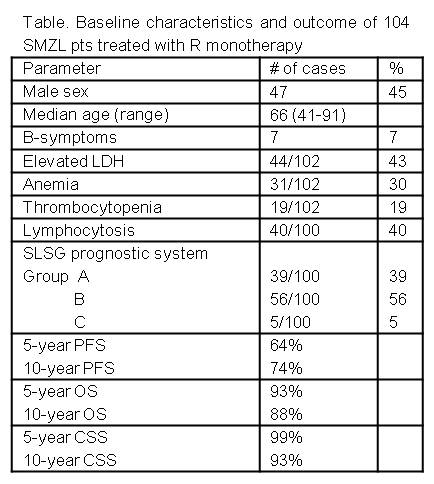SPLENIC MARGINAL ZONE LYMPHOMA (SMZL) TREATED WITH RITUXIMAB (R) MONOTHERAPY: A LONG TERM FOLLOW-UP STUDY ON 104 PATIENTS
(Abstract release date: 05/18/17)
EHA Library. Kalpadakis C. 06/24/17; 181703; S416

Dr. Christina Kalpadakis
Contributions
Contributions
Abstract
Abstract: S416
Type: Oral Presentation
Presentation during EHA22: On Saturday, June 24, 2017 from 12:30 - 12:45
Location: Hall B
Background
Rituximab monotherapy has been used successfully in the treatment of SMZL and it can replace splenectomy, at least in 1st line.
Aims
To present our data on the outcome of R monotherapy treated pts after a long term follow-up.
Methods
The diagnosis of SMZL was based on the WHO criteria. Criteria for treatment initiation included: bulky/symptomatic splenomegaly, cytopenias or presence of B-symptoms. All pts received 6 weekly cycles of R as 1st line therapy at a dose of 375mg/m2 (induction phase). None of the pts had been splenectomised before R treatment. Maintenance with R at a dose of 375mg/m2 every 2 months for 1-2 years was given according to physician’s discretion. Response assessment was based on the SLSG consensus criteria. Survival curves were estimated using the Kaplan Meier method and compared by log-rank test.
Results
104 pts with SMZL were included. 45% were males with a median age of 66 y (41-91). At diagnosis all pts had bone marrow infiltration with a median % of infiltration of 40 (10-85). Anemia and thrombocytopenia were present in 30% and 19%, respectively. 40% had absolute lymphocytosis. LDH was elevated in 43%. According to the SLSG prognostic system, 39% were classified in group A, 56% in group B and 5% in group C. The median time from diagnosis to treatment initiation was 2 months (0-203). 71 pts received R maintenance. The overall response rate 2 months after the end of induction treatment was 93% (CR, CRu and PR in 42%, 21% and 30%, respectively). Maintenance therapy improved the quality of response in 19 of them, 52 pts maintained their initial response and one relapsed during maintenance phase. The 5- and 10-year PFS, OS and CSS were 70% and 64%, 93% and 88%, 99% and 93%, respectively. Maintenance therapy was associated with better PFS (p=0.008). 22 pts relapsed (6 of them with histologic transformation to DLBCL). 11/22 were retreated with R and 9/11 responded. 8 deaths were recorded: 3 of them disease related. R therapy was well tolerated. Only one pt could not complete treatment due to intolerance.

Conclusion
The present study, includes a large number of pts with a long follow-up, confirms that R monotherapy is very effective in SMZL with minimal toxicity and is recommended as the treatment of choice for this disease.
Session topic: 19. Indolent Non-Hodgkin lymphoma - Clinical
Keyword(s): Splenic marginal zone lymphoma, Rituximab
Abstract: S416
Type: Oral Presentation
Presentation during EHA22: On Saturday, June 24, 2017 from 12:30 - 12:45
Location: Hall B
Background
Rituximab monotherapy has been used successfully in the treatment of SMZL and it can replace splenectomy, at least in 1st line.
Aims
To present our data on the outcome of R monotherapy treated pts after a long term follow-up.
Methods
The diagnosis of SMZL was based on the WHO criteria. Criteria for treatment initiation included: bulky/symptomatic splenomegaly, cytopenias or presence of B-symptoms. All pts received 6 weekly cycles of R as 1st line therapy at a dose of 375mg/m2 (induction phase). None of the pts had been splenectomised before R treatment. Maintenance with R at a dose of 375mg/m2 every 2 months for 1-2 years was given according to physician’s discretion. Response assessment was based on the SLSG consensus criteria. Survival curves were estimated using the Kaplan Meier method and compared by log-rank test.
Results
104 pts with SMZL were included. 45% were males with a median age of 66 y (41-91). At diagnosis all pts had bone marrow infiltration with a median % of infiltration of 40 (10-85). Anemia and thrombocytopenia were present in 30% and 19%, respectively. 40% had absolute lymphocytosis. LDH was elevated in 43%. According to the SLSG prognostic system, 39% were classified in group A, 56% in group B and 5% in group C. The median time from diagnosis to treatment initiation was 2 months (0-203). 71 pts received R maintenance. The overall response rate 2 months after the end of induction treatment was 93% (CR, CRu and PR in 42%, 21% and 30%, respectively). Maintenance therapy improved the quality of response in 19 of them, 52 pts maintained their initial response and one relapsed during maintenance phase. The 5- and 10-year PFS, OS and CSS were 70% and 64%, 93% and 88%, 99% and 93%, respectively. Maintenance therapy was associated with better PFS (p=0.008). 22 pts relapsed (6 of them with histologic transformation to DLBCL). 11/22 were retreated with R and 9/11 responded. 8 deaths were recorded: 3 of them disease related. R therapy was well tolerated. Only one pt could not complete treatment due to intolerance.

Conclusion
The present study, includes a large number of pts with a long follow-up, confirms that R monotherapy is very effective in SMZL with minimal toxicity and is recommended as the treatment of choice for this disease.
Session topic: 19. Indolent Non-Hodgkin lymphoma - Clinical
Keyword(s): Splenic marginal zone lymphoma, Rituximab
{{ help_message }}
{{filter}}


